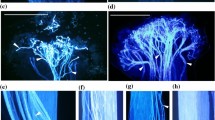Abstract
Prunus necrotic ringspot Ilarvirus (PNRSV) is a pollen and seed-borne ilarvirus affecting most Prunus spp. The location of the virus in infected nectarine pollen grains was investigated by molecular hybridisation, RT-PCR and in situ hybridisation. The first two approaches revealed an internal location of the virus. In situ hybridisation demonstrated the virus in the bicellular pollen grain, where it was present in the cytoplasm of the vegetative cell but not in the generative cell. This result seems to indicate that the sperm cells, formed by the mitosis of the generative cell, are not involved in virus transmission to seed. Other possible mechanisms are discussed.
Similar content being viewed by others
References
Cole A, Mink GI and Regev S (1982) Location of Prunus necrotic ringspot virus on pollen grains from infected almond and cherry trees. Phytopathology 72: 1542-1545
Digiaro M, Di Terlizzi B and Savino V (1992) Ilarviruses in apricot and plum pollen. Acta Hortic 309: 93-98
Greber RS, Klose MJ, Milne JR and Teakle DS (1991) Transmission of prunus necrotic ringspot using plum pollen and thrips. Ann Appl Biol 118: 580-593
Greber RS, Teakle DS and Mink GI (1992) Thrips-facilitated transmission of prune dwarf and prunus necrotic ringspot viruses from cherry pollen to cucumber. Plant Dis 76: 1039-1041
Hamilton RI, Nichols C and Valentina B (1984) Survey of Prunus necrotic ringspot and other viruses contaminating the exine of pollen collected by bees. Can J Plant Pathol 6: 196-199
Johansen E, Edwards MC and Hampton RO (1994) Seed transmission of viruses: current perspectives. Ann Rev Phytopathol 32: 363-386
Karnovsky MJ (1965) A formaldehyde-glutaraldehyde fixative of high osmolarity for use in electron microscopy. J Cell Biol 27: 137A-138B
Kelley RD and Cameron HR (1986) Location of prune dwarf and prunus necrotic ringspot viruses associated with sweet cherry pollen and seed. Phytopathology 76: 317-322
Mascarenhas JP (1989) The male gametophyte of flowering plants. Plant Cell 1: 657-664
Maule AJ and Wang D (1996) Seed transmission of plant viruses: a lesson in biological complexity. Trends in Microbiol 4: 153-158
Mink GI (1992) Ilarvirus Vectors. Adv. Dis. Vector Res 9: 261-281
Murphy FA, Fauquet CM, Bishop DHL, Ghabrial SA, Jarvis AW, Martelli GP, Mayo MA and Summers MD (1995) Virus Taxonomy. Classification and Nomenclature of Viruses. Sixth Report of the International Committee on Taxonomy of Viruses. Springer, Wien New York (Archives of Virology [Suppl] 10)
Pallás V, Más P and Sánchez-Navarro JA (1998) Detection of plant RNA viruses by non-isotopic dot-blot hybridisation. In: Foster G and Taylor S (eds) Plant Virus Protocols: From Virus Isolation to Transgenic Resistance (pp 471-478). Humana Press, Totowa, New Jersey
Pesic Z, Hiruki C and Chen MH (1988) Detection of viral antigen by immunogold cytochemistry in ovules, pollen and anthers of alfalfa infected with alfalfa mosaic virus. Phytopatholology 78: 1027-1032
Russell SD (1995) The egg cell: development and role in fertilisation and early embriogenesis. Plant Cell 5: 1349-1359
Sánchez-Navarro JA and Pallás V (1997) Evolutionary relathionships in the ilarviruses: nucleotide sequence of prunus necrotic ringspot RNA 3. Arch Virol 142: 749-763
Sánchez-Navarro JA, Reusken CBEM, Bol JF and Pallás V (1997) Replication of alfalfa mosaic virus RNA 3 with movement and coat protein genes replaced by corresponding genes of Prunus necrotic ringspot Ilarvirus. J Gen Virol 78: 3171-3176
Sánchez-Navarro JA, Aparicio F, Rowhani A and Pallás V (1998) Comparative analysis of ELISA, non-radioactive molecular hybridisation and PCR for the detection of Prunus necrotic ringspot virus in herbaceous and Prunus hosts. Plant Pathol 47: 780-786
Sánchez-Pina MA, Más P and Pallás V (1998) Tubular structures formed by cherry leaf roll nepovirus (CLRV) in systemically infected Nicotiana tabaccum leaf cells: immunocytochemistry and in situ hybridization. In: Electron Microscopy 96, Vol. 3 (pp 187-188), edited and published by the Committe of European Societies of Microscopy, Brussels
Uyemoto JK, Asai WK and Luhn F (1992) Ilarviruses: evidence for rapid spread and effects on vegetative growth and fruit yields of peach trees. Plant Dis 76: 71-74
Author information
Authors and Affiliations
Corresponding author
Rights and permissions
About this article
Cite this article
Aparicio, F., Sánchez-Pina, M.A., Sánchez-Navarro, J.A. et al. Location of Prunus Necrotic Ringspot Ilarvirus Within Pollen Grains of Infected Nectarine Trees: Evidence from RT-PCR, Dot-blot and in situ Hybridisation. European Journal of Plant Pathology 105, 623–627 (1999). https://doi.org/10.1023/A:1008783705183
Issue Date:
DOI: https://doi.org/10.1023/A:1008783705183




